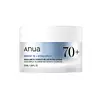What's inside
What's inside
 Key Ingredients
Key Ingredients

 Benefits
Benefits

 Concerns
Concerns

 Ingredients Side-by-side
Ingredients Side-by-side

Betula Platyphylla Japonica Juice 70%
Skin ConditioningDipropylene Glycol
HumectantButylene Glycol
HumectantWater
Skin ConditioningSqualane
EmollientCaprylic/Capric Triglyceride
Masking1,2-Hexanediol
Skin ConditioningC12-16 Alcohols
EmollientHydroxyethyl Acrylate/Sodium Acryloyldimethyl Taurate Copolymer
Emulsion StabilisingAmmonium Acryloyldimethyltaurate/Vp Copolymer
Polyglyceryl-2 Stearate
EmulsifyingGlyceryl Stearate
EmollientPalmitic Acid
EmollientHydrogenated Lecithin
EmulsifyingStearyl Alcohol
EmollientCaprylyl Glycol
EmollientSorbitan Isostearate
EmulsifyingDextrin
AbsorbentAllantoin
Skin ConditioningBetaine
HumectantCucumis Sativus Fruit Extract
EmollientGluconolactone
Skin ConditioningPanthenol
Skin ConditioningGardenia Florida Fruit Extract
Skin ConditioningUlmus Davidiana Root Extract
Skin ConditioningPinus Palustris Leaf Extract
TonicPueraria Lobata Root Extract
HumectantOenothera Biennis Flower Extract
AstringentDipotassium Glycyrrhizate
HumectantTocopherol
AntioxidantMalachite Extract
AntioxidantSodium Hyaluronate
HumectantHydroxypropyltrimonium Hyaluronate
Hydrolyzed Hyaluronic Acid
HumectantSodium Acetylated Hyaluronate
HumectantHyaluronic Acid
HumectantHydrolyzed Sodium Hyaluronate
Skin ConditioningSodium Hyaluronate Crosspolymer
HumectantPotassium Hyaluronate
Skin ConditioningEthylhexylglycerin
Skin ConditioningHydroxyacetophenone
AntioxidantDisodium EDTA
Betula Platyphylla Japonica Juice 70%, Dipropylene Glycol, Butylene Glycol, Water, Squalane, Caprylic/Capric Triglyceride, 1,2-Hexanediol, C12-16 Alcohols, Hydroxyethyl Acrylate/Sodium Acryloyldimethyl Taurate Copolymer, Ammonium Acryloyldimethyltaurate/Vp Copolymer, Polyglyceryl-2 Stearate, Glyceryl Stearate, Palmitic Acid, Hydrogenated Lecithin, Stearyl Alcohol, Caprylyl Glycol, Sorbitan Isostearate, Dextrin, Allantoin, Betaine, Cucumis Sativus Fruit Extract, Gluconolactone, Panthenol, Gardenia Florida Fruit Extract, Ulmus Davidiana Root Extract, Pinus Palustris Leaf Extract, Pueraria Lobata Root Extract, Oenothera Biennis Flower Extract, Dipotassium Glycyrrhizate, Tocopherol, Malachite Extract, Sodium Hyaluronate, Hydroxypropyltrimonium Hyaluronate, Hydrolyzed Hyaluronic Acid, Sodium Acetylated Hyaluronate, Hyaluronic Acid, Hydrolyzed Sodium Hyaluronate, Sodium Hyaluronate Crosspolymer, Potassium Hyaluronate, Ethylhexylglycerin, Hydroxyacetophenone, Disodium EDTA
Houttuynia Cordata Extract 70%
Skin ConditioningCetearyl Alcohol
EmollientGlycerin
HumectantCyclohexasiloxane
EmollientButylene Glycol
Humectant1,2-Hexanediol
Skin ConditioningDicaprylyl Ether
EmollientCaprylic/Capric Triglyceride
MaskingHydrogenated Poly(C6-14 Olefin)
EmollientHydrogenated Polydecene
EmollientGlyceryl Stearate Se
EmulsifyingCetearyl Olivate
Sorbitan Olivate
EmulsifyingVegetable Oil
Skin ConditioningPanthenol
Skin ConditioningHydrogenated Lecithin
EmulsifyingDipropylene Glycol
HumectantBehenyl Alcohol
EmollientAmmonium Acryloyldimethyltaurate/Vp Copolymer
Cetearyl Glucoside
EmulsifyingCholesterol
EmollientXanthan Gum
EmulsifyingAdenosine
Skin ConditioningCeramide NP
Skin ConditioningGlucose
HumectantWater
Skin ConditioningEthylhexylglycerin
Skin ConditioningHouttuynia Cordata Extract 70%, Cetearyl Alcohol, Glycerin, Cyclohexasiloxane, Butylene Glycol, 1,2-Hexanediol, Dicaprylyl Ether, Caprylic/Capric Triglyceride, Hydrogenated Poly(C6-14 Olefin), Hydrogenated Polydecene, Glyceryl Stearate Se, Cetearyl Olivate, Sorbitan Olivate, Vegetable Oil, Panthenol, Hydrogenated Lecithin, Dipropylene Glycol, Behenyl Alcohol, Ammonium Acryloyldimethyltaurate/Vp Copolymer, Cetearyl Glucoside, Cholesterol, Xanthan Gum, Adenosine, Ceramide NP, Glucose, Water, Ethylhexylglycerin
 Reviews
Reviews

Ingredients Explained
These ingredients are found in both products.
Ingredients higher up in an ingredient list are typically present in a larger amount.
1,2-Hexanediol is a synthetic liquid and another multi-functional powerhouse.
It is a:
- Humectant, drawing moisture into the skin
- Emollient, helping to soften skin
- Solvent, dispersing and stabilizing formulas
- Preservative booster, enhancing the antimicrobial activity of other preservatives
Ammonium Acryloyldimethyltaurate/Vp Copolymer (let's call it AAVC for short) is a synthetically created polymer. It's used as a film-forming agent and used to thicken the consistency of products.
AAVC is able to increase the consistency and viscosity of products due to its large molecule size. It also prevents ingredients from separating.
Butylene Glycol (or BG) is used within cosmetic products for a few different reasons:
Overall, Butylene Glycol is a safe and well-rounded ingredient that works well with other ingredients.
Though this ingredient works well with most skin types, some people with sensitive skin may experience a reaction such as allergic rashes, closed comedones, or itchiness.
Learn more about Butylene GlycolThis ingredient is an emollient, solvent, and texture enhancer. It is considered a skin-softener by helping the skin prevent moisture loss.
It helps thicken a product's formula and makes it easier to spread by dissolving clumping compounds.
Caprylic Triglyceride is made by combining glycerin with coconut oil, forming a clear liquid.
While there is an assumption Caprylic Triglyceride can clog pores due to it being derived from coconut oil, there is no research supporting this.
Learn more about Caprylic/Capric TriglycerideDipropylene Glycol is a synthetically created humectant, stabilizer, and solvent.
This ingredient helps:
Dipropylene glycol is technically an alcohol, but it belongs to the glycol family (often considered part of the ‘good’ alcohols). This means it is hydrating and gentle on skin unlike drying solvent alcohols like denatured alcohol.
As a masking agent, Dipropylene Glycol can be used to cover the smell of other ingredients. However, it does not have a scent.
Studies show Dipropylene Glycol is considered safe to use in skincare.
Learn more about Dipropylene GlycolEthylhexylglycerin (we can't pronounce this either) is commonly used as a preservative and skin softener. It is derived from glyceryl.
You might see Ethylhexylglycerin often paired with other preservatives such as phenoxyethanol. Ethylhexylglycerin has been found to increase the effectiveness of these other preservatives.
Hydrogenated Lecithin is created from the hydrogenation of lecithin (a group of phospholipids). Hydrogenation is a chemical reaction between hydrogen and another element.
This ingredient is an emollient and emulsifier. As an emollient, it helps soften skin by trapping moisture within. As an emulsifier, it prevents oil and water ingredients from separating.
Panthenol is a common ingredient that helps hydrate and soothe the skin. It is found naturally in our skin and hair.
There are two forms of panthenol: D and L.
D-panthenol is also known as dexpanthenol. Most cosmetics use dexpanthenol or a mixture of D and L-panthenol.
Panthenol is famous due to its ability to go deeper into the skin's layers. Using this ingredient has numerous pros (and no cons):
Like hyaluronic acid, panthenol is a humectant. Humectants are able to bind and hold large amounts of water to keep skin hydrated.
This ingredient works well for wound healing. It works by increasing tissue in the wound and helps close open wounds.
Once oxidized, panthenol converts to pantothenic acid. Panthothenic acid is found in all living cells.
This ingredient is also referred to as pro-vitamin B5.
Learn more about PanthenolWater. It's the most common cosmetic ingredient of all. You'll usually see it at the top of ingredient lists, meaning that it makes up the largest part of the product.
So why is it so popular? Water most often acts as a solvent - this means that it helps dissolve other ingredients into the formulation.
You'll also recognize water as that liquid we all need to stay alive. If you see this, drink a glass of water. Stay hydrated!
Learn more about Water